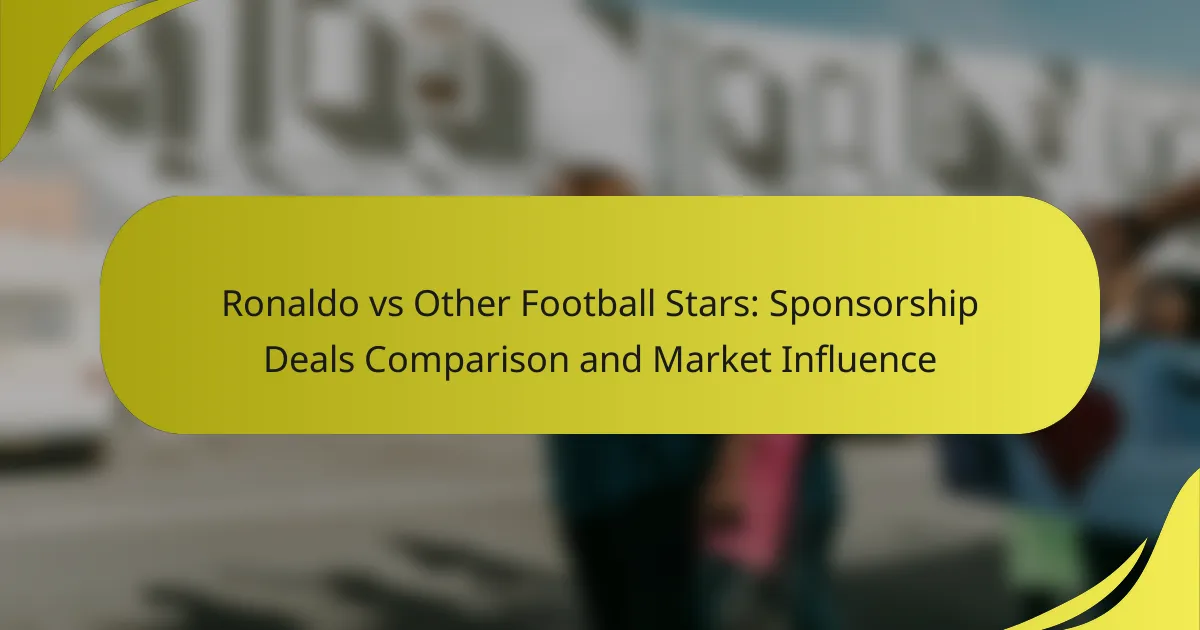Cristiano Ronaldo stands out in the football world not only for his athletic prowess but also for his exceptional sponsorship deals, which often eclipse those of other football stars. His strategic partnerships with high-profile brands like Adidas and Herbalife amplify his market influence, driving significant visibility and consumer engagement for the companies he represents. As a result, Ronaldo’s brand appeal plays a crucial role in shaping market trends and athlete endorsements globally.
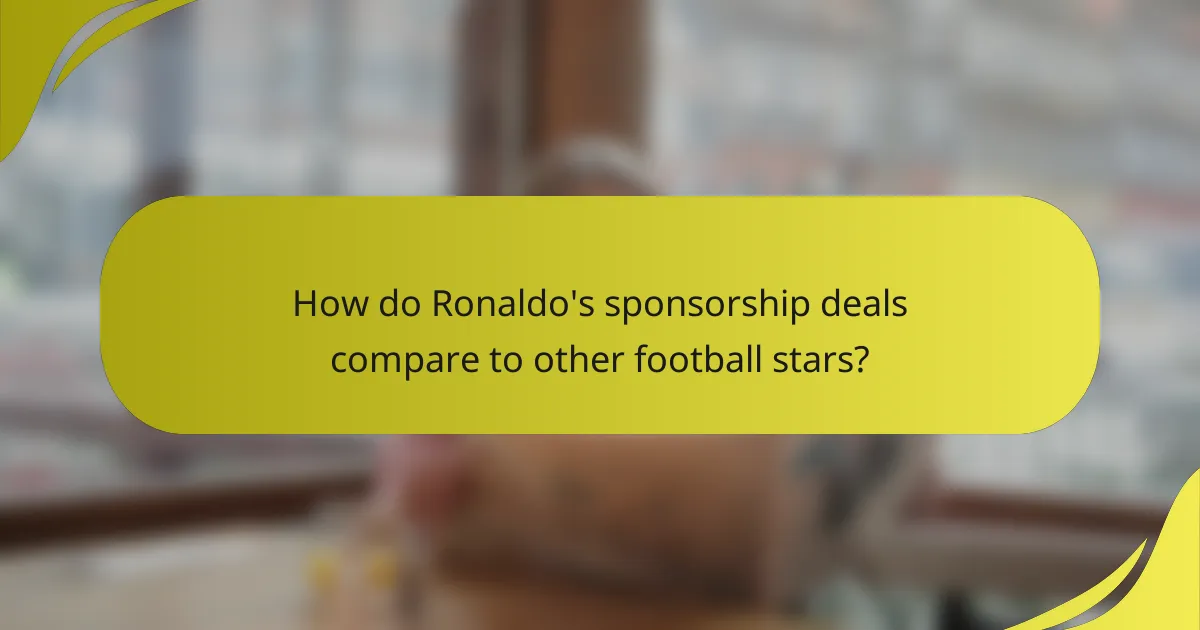
How do Ronaldo’s sponsorship deals compare to other football stars?
Ronaldo’s sponsorship deals are among the most lucrative in the football world, often surpassing those of his peers. His strategic partnerships and global brand appeal significantly influence market trends and athlete endorsements.
Ronaldo’s major sponsorships
Ronaldo has secured high-profile sponsorships with brands like Nike, Herbalife, and Clear. His lifetime deal with Nike is estimated to be worth hundreds of millions, reflecting his immense marketability. Additionally, his own CR7 brand further amplifies his influence in the sports and fashion industries.
Comparative analysis with Messi
While both Ronaldo and Messi command substantial sponsorships, Ronaldo typically earns more from endorsements. Messi’s partnerships include Adidas and Budweiser, but Ronaldo’s global reach and social media presence often translate to higher earnings. Their contrasting styles and personalities also shape their respective brand images, influencing the types of deals they attract.
Influence of Neymar’s endorsements
Neymar’s endorsements, including partnerships with Puma and Red Bull, showcase his growing market influence, particularly in Brazil and among younger audiences. His ability to connect with fans through social media enhances his appeal to brands. However, Neymar’s earnings from endorsements are generally lower than Ronaldo’s, reflecting differing market positions.
Key differences with Mbappé’s contracts
Mbappé, as a rising star, has begun to secure significant sponsorships, such as with Nike and Hublot. However, his earnings from endorsements are still developing compared to Ronaldo’s established portfolio. The key difference lies in the maturity of their careers; Ronaldo’s extensive experience and established brand make his deals more lucrative and diverse.
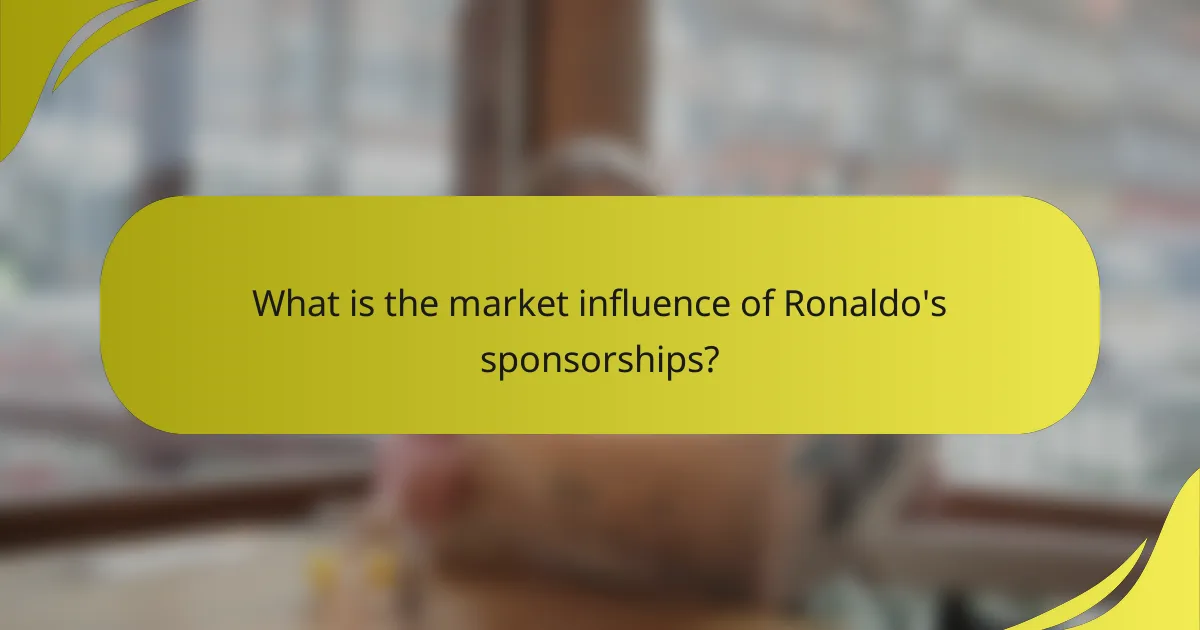
What is the market influence of Ronaldo’s sponsorships?
Ronaldo’s sponsorships significantly enhance brand visibility and influence consumer behavior, making him a powerful asset for companies. His global appeal and market presence translate into substantial financial benefits for partnered brands.
Impact on brand visibility
Ronaldo’s sponsorships elevate brand visibility by associating products with his renowned image. Brands that partner with him often experience increased recognition in both traditional and digital media. For example, companies like Nike and Herbalife have leveraged his status to reach wider audiences, resulting in enhanced brand awareness.
Moreover, his appearances in advertisements and social media campaigns create a strong visual connection between the brand and his persona, which can lead to long-lasting consumer impressions.
Effect on sales for partnered brands
Brands that collaborate with Ronaldo typically see a notable boost in sales, often in the double-digit percentage range. His endorsement can drive consumer interest, leading to increased purchases of products he promotes. For instance, after Ronaldo’s partnership with a sports drink brand, sales reportedly surged significantly within months.
However, the effectiveness of these sponsorships can vary based on the product’s alignment with Ronaldo’s image and the target market’s demographics. Brands must ensure that their offerings resonate with his fan base to maximize sales impact.
Ronaldo’s social media reach
Ronaldo boasts one of the largest social media followings in the world, with hundreds of millions of followers across platforms like Instagram and Facebook. This extensive reach allows brands to tap into a vast audience, amplifying their marketing messages effectively. His posts often garner millions of likes and comments, showcasing the engagement potential for sponsored content.
Additionally, his ability to connect with fans through personal stories and lifestyle content enhances the authenticity of brand partnerships. Companies can leverage this engagement to foster a deeper connection with consumers, ultimately driving brand loyalty and sales.
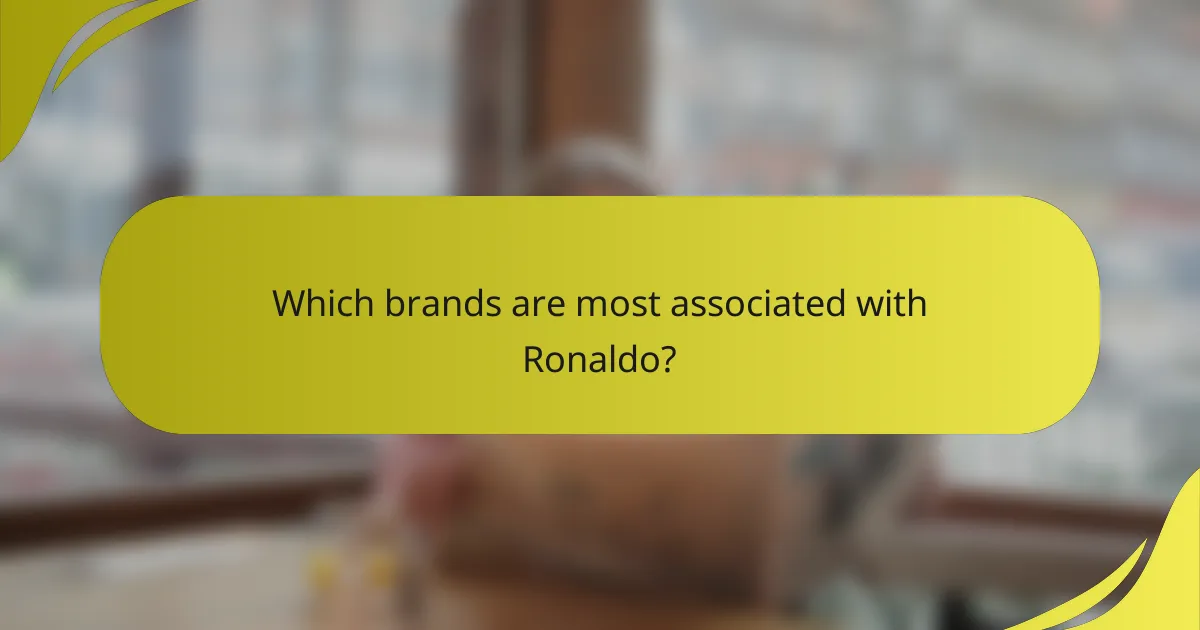
Which brands are most associated with Ronaldo?
Cristiano Ronaldo is closely linked with several high-profile brands, most notably Adidas, CR7, and Herbalife. These partnerships significantly enhance his market influence and visibility in the sports and lifestyle sectors.
Adidas partnership details
Ronaldo’s partnership with Adidas is one of the most prominent in sports marketing. He has been a key figure in promoting their products, particularly football boots and apparel, which has helped Adidas maintain a strong presence in the global sports market.
This collaboration includes exclusive lines of footwear and training gear, often featuring Ronaldo’s signature branding. The financial terms of such deals typically range from tens of millions to over a hundred million USD, depending on performance and market impact.
CR7 brand overview
The CR7 brand encompasses a wide array of products, including footwear, clothing, and fragrances. Launched by Ronaldo, this brand capitalizes on his personal brand and global appeal, making it a lucrative venture.
With revenues estimated in the low tens of millions USD annually, the CR7 brand continues to expand into new markets, leveraging Ronaldo’s fame to attract consumers. The brand’s success is a testament to effective marketing and Ronaldo’s strong personal image.
Role of Herbalife in sponsorship
Herbalife has been a significant sponsor of Ronaldo, focusing on nutrition and wellness products. This partnership aligns with Ronaldo’s image as a fitness icon, promoting healthy living and athletic performance.
Through this collaboration, Herbalife benefits from Ronaldo’s vast reach, while he endorses their products, often sharing personal experiences with their supplements. The financial aspects of this sponsorship are substantial, contributing significantly to both parties’ marketing strategies.

What are the financial implications of football sponsorships?
Football sponsorships can significantly impact a player’s income and brand value. These deals often involve substantial financial commitments from brands, which can range from millions to tens of millions of dollars annually, depending on the player’s marketability and global reach.
Revenue generated by Ronaldo’s deals
Cristiano Ronaldo’s sponsorship deals are among the most lucrative in sports, contributing a significant portion of his overall earnings. His partnerships with brands like Nike and Herbalife reportedly generate revenues in the high tens of millions each year, showcasing his immense market influence.
Ronaldo’s social media presence further amplifies his sponsorship revenue, as brands leverage his vast following to reach millions of potential customers. This synergy between his on-field success and off-field endorsements creates a powerful financial engine.
Comparison of sponsorship values
When comparing sponsorship values among football stars, Ronaldo typically leads the pack, often surpassing rivals like Lionel Messi and Neymar. While Messi’s deals also reach impressive figures, Ronaldo’s unique brand appeal and global reach often translate into higher annual earnings from endorsements.
For instance, while Messi’s sponsorships may range in the tens of millions, Ronaldo’s can exceed these figures, reflecting his status as a global icon. This disparity highlights the importance of personal branding and marketability in determining sponsorship values within the football industry.

How do sponsorship deals affect player marketability?
Sponsorship deals significantly enhance a player’s marketability by increasing their visibility and financial value. These partnerships often lead to greater media exposure, fan engagement, and additional revenue streams, which can elevate a player’s overall brand in the sports industry.
Ronaldo’s marketability metrics
Cristiano Ronaldo’s marketability metrics are among the highest in the football world, driven by his global fanbase and social media presence. His endorsement deals with major brands like Nike and Herbalife contribute to his estimated earnings from sponsorships, which can reach into the high tens of millions of dollars annually.
Ronaldo’s ability to connect with fans through various platforms amplifies his marketability. His social media following, which numbers in the hundreds of millions, allows brands to reach vast audiences, making him a highly sought-after figure for sponsorships.
Influence of endorsements on player contracts
Endorsements can significantly influence player contracts, as clubs often consider a player’s marketability when negotiating salaries. Players with strong endorsement deals may command higher wages, reflecting their ability to attract sponsorship revenue for the team.
For example, a player with multiple lucrative endorsements may negotiate a contract that includes performance bonuses tied to their marketability. This can create a win-win situation, where the player benefits financially while the club gains from increased visibility and potential sponsorship opportunities.
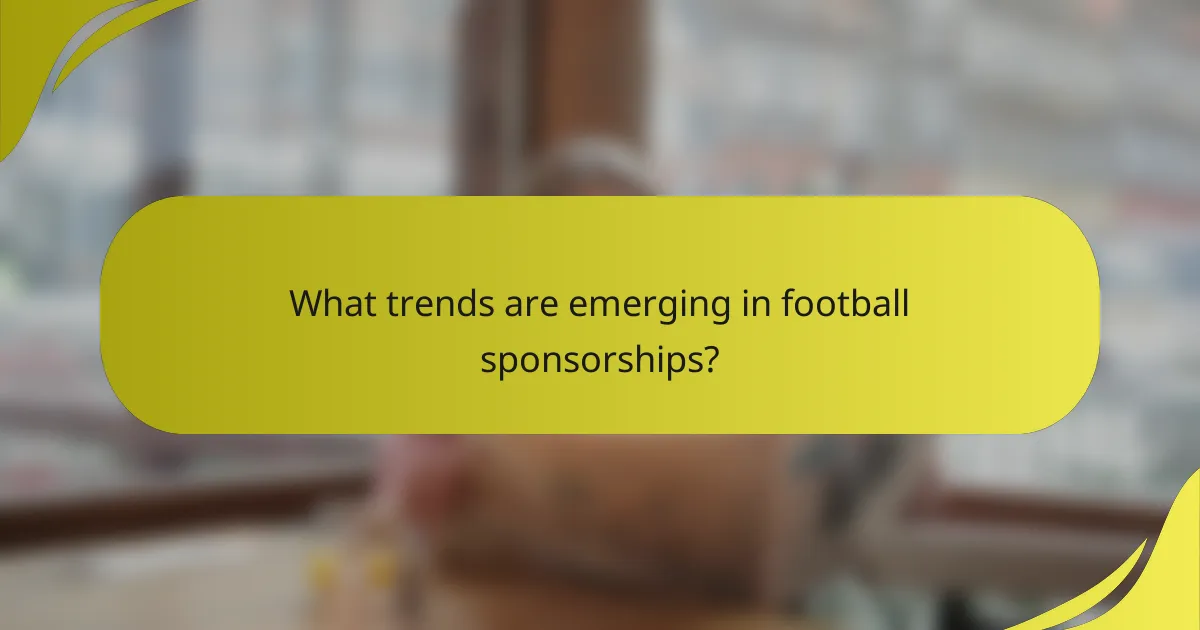
What trends are emerging in football sponsorships?
Emerging trends in football sponsorships reflect a shift towards digital platforms and the increasing influence of social media. Brands are focusing on innovative ways to engage fans through online channels, making sponsorships more dynamic and interactive.
Shift towards digital endorsements
The shift towards digital endorsements is reshaping how brands collaborate with football stars. Traditional advertising is giving way to more interactive campaigns that leverage online platforms, allowing for real-time engagement with fans. This trend is evident as sponsorship deals increasingly include digital content creation, such as social media posts and live-streamed events.
For instance, many players now promote products through their personal social media accounts, often resulting in higher engagement rates compared to conventional advertising methods. Brands are recognizing the value of these digital endorsements, which can reach millions of followers instantly, often at a fraction of the cost of traditional media buys.
Growing importance of social media influencers
Social media influencers are becoming pivotal in football sponsorship strategies. Influencers, including football stars, possess the ability to connect with audiences on a personal level, making their endorsements more relatable and impactful. This trend is particularly strong among younger fans who are more likely to trust recommendations from their favorite players on platforms like Instagram and TikTok.
Brands are increasingly collaborating with both established football stars and rising influencers to maximize their reach. For example, a campaign featuring a well-known player alongside a popular social media influencer can significantly enhance brand visibility and engagement. Companies should consider integrating influencer partnerships into their sponsorship strategies to tap into this growing market influence effectively.

What can we expect from future sponsorship deals?
Future sponsorship deals in football are likely to evolve significantly, driven by digital engagement and the growing influence of social media. Brands are increasingly looking for partnerships that not only enhance visibility but also resonate with younger audiences and leverage innovative marketing strategies.
Emerging trends in sponsorship deals
Emerging trends in sponsorship deals include a stronger emphasis on digital platforms and influencer marketing. Brands are shifting their focus towards athletes with substantial social media followings, as these players can reach millions of fans instantly. This trend is expected to continue, with more companies prioritizing online engagement over traditional advertising methods.
Additionally, sustainability and social responsibility are becoming critical factors in sponsorship agreements. Brands are increasingly aligning with athletes who advocate for environmental causes or social issues, reflecting a broader consumer demand for ethical practices.
Key factors influencing sponsorship value
Several key factors influence the value of sponsorship deals, including an athlete’s marketability, performance, and personal brand. High-profile players like Cristiano Ronaldo command higher deals due to their global recognition and consistent performance on the field. In contrast, emerging stars may need to build their brand and audience before securing lucrative partnerships.
Market conditions also play a role; during economic downturns, brands may tighten budgets, affecting sponsorship spending. Conversely, in booming markets, companies might invest more heavily in athlete endorsements to capitalize on increased consumer spending.
Comparative analysis of top football stars
When comparing sponsorship deals among top football stars, Cristiano Ronaldo and Lionel Messi often lead the pack, with deals ranging from tens of millions to over a hundred million USD annually. Other notable players like Neymar and Kylian Mbappé also secure substantial agreements, but typically at lower values than Ronaldo and Messi.
For instance, Ronaldo’s partnerships with brands like Nike and Herbalife showcase his ability to leverage his image effectively, while Messi’s deals with Adidas and Pepsi highlight his global appeal. The differences in their sponsorship values often reflect their market presence, fan engagement, and the strategic alignment of their personal brands with corporate values.
